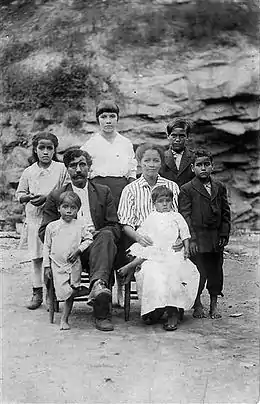Меланджен
Меланджен (англ. Melungeon, məˈlʌndʒən) — термин, обозначающий в США потомков от смешанных браков представителей трёх рас — белой, негроидной и американоидной[1]. В более узком смысле термин относится к потомкам от таких браков, проживающим на юго-востоке США, в основном в центральных Аппалачах — восток Теннеси, юго-запад Виргинии, восток Кентукки.

История
Термин происходит от французского слова mélange, то есть «смесь». Меланджены, в свою очередь, делятся на различные культурные группы, численность которых, по различным классификациям, достигает 200[2][3].
До конца XX века слово «меланджен» считалось унизительным. Перелом произошёл в 1969 году, когда драматург Кермит Хантер поставил драму «Пешком к закату» (Walk Toward the Sunset)[4]. Хантер, не особенно стараясь соблюсти историческую точность, изобразил меландженов коренным населением неизвестной расы, которых белые поселенцы из-за цвета кожи принимали за негров. В настоящее время термин «меланджен» используется его носителями для культурной самоидентификации.
Интерес к меландженам в США значительно вырос в середине 1990-х годов после выхода посвящённых им книг: Билла Брайсона «Потерянный континент» (en:The Lost Continent: Travels in Small-Town America) и Н. Брент Кеннеди «Меланджен: воскрешение гордых людей» (The Melungeons: The Resurrection of a Proud People).
Примечания
- Melungeon Heritage Association (недоступная ссылка). Дата обращения: 23 ноября 2009. Архивировано 11 апреля 2008 года.
- William Harlan Gilbert, Jr., «Surviving Indian Groups of the Eastern United States», Report to the Board of Regents of The Smithsonian Institution, 1948 (недоступная ссылка). Дата обращения: 26 сентября 2019. Архивировано 25 января 2019 года.
- Donald B. Ball and John S. Kessler, «North from the Mountains: The Carmel Melungeons of Ohio», Paper presented at Melungeon Heritage Association Third Union, 20 May 2000 at University of VA’s College at Wise, Virginia Accessed 14 Mar 2008
- Ivey, Saundra K. Oral, Printed & Popular Culture Traditions Related to the Melungeons of Hancock County, TN, Indiana U. dissertation, 1976;
Литература
- Ball, Bonnie (1992). The Melungeons (Notes on the Origin of a Race). Johnson City, Tennessee: Overmountain Press.
- Berlin, Ira (1998). Many Thousands Gone : The First Two Centuries of Slavery in North America. Cambridge, Massachusetts: Belknap Press of Harvard University Press
- Berry, Brewton (1963). Almost White: A Study of Certain Racial Hybrids in the Eastern United States. New York: Macmillan Press.
- Bible, Jean Patterson (1975). Melungeons Yesterday and Today. Signal Mountain, Tennessee: Mountain Press.
- Bryson, Bill. (1989). The Lost Continent : Travels in Small Town America.
- DeMarce, Virginia E. (1992). «Verry Slitly Mixt': Tri-Racial Isolate Families of the Upper South — A Genealogical Study.» National Genealogical Society Quarterly 80 (March 1992): 5-35.
- DeMarce, Virginia E. (1993). «Looking at Legends — Lumbee and Melungeon: Applied Genealogy and the Origins of Tri-Racial Isolate Settlements.» National Genealogical Society Quarterly 81 (March 1993): 24-45.
- DeMarce, Virginia E. (1996). Review of The Melungeons: Resurrection of a Proud People. National Genealogical Society Quarterly 84 (June 1996): 134—149.
- Dromgoole, Will Allen (1890). «Land of the Malungeons» Nashville Daily American, newspaper, writing under the name Will Allen, August 31, 1890: 10. Article available at:
- Elder, Pat Spurlock (1999). Melungeons: Examining an Appalachian Legend. Blountville, Tennessee: Continuity Press.
- Evans, E. Raymond (1979). «The Graysville Melungeons: A Tri-racial People in Lower East Tennessee.» Tennessee Anthropologist IV(1): 1-31.
- Everett, Christopher (1998). «Melungeon Historical Realities: Reexamining a Mythopoeia of the Southern United States». Conference paper, Conference on Innovative Perspectives in History. Blacksburg, Virginia: Graduate Program, Department of History, Virginia Polytechnic Institute and State University, April 17-18, 1998.
- Forbes, Jack D. (1993). Africans and Native Americans The Language of Race and the Evolution of Red-Black Peoples. University of Illinois Press.
- Goins, Jack H. (2000). Melungeons: And Other Pioneer Families. Blountville, Tennessee: Continuity Press.
- Heinegg, Paul (2005). FREE AFRICAN AMERICANS OF VIRGINIA, NORTH CAROLINA, SOUTH CAROLINA, MARYLAND AND DELAWARE Including the family histories of more than 80 % of those counted as «all other free persons» in the 1790 and 1800 census. Available in its entirety online at freeafricanamericans.com
- Johnson, Mattie Ruth (1997). My Melungeon Heritage: A Story of Life on Newman’s Ridge. Johnson City, Tennessee: Overmountain Press.
- Kennedy, N. Brent, with Robyn Vaughan Kennedy (1994). The Melungeons: The Resurrection of a Proud People. Macon, Georgia: Mercer University Press.
- Langdon, Barbara Tracy (1998). The Melungeons: An Annotated Bibliography: References in both Fiction and Nonfiction. Hemphill, Texas: Dogwood Press.
- McGowan, Kathleen (2003). «Where do we really come from?» DISCOVER 24 (5, May 2003). Available at
- Offutt, Chris. (1999) «Melungeons.» Out of the Woods Simon & Schuester.
- Price, Edward T. (1953). «A Geographic Analysis of White-Negro-Indian Racial Mixtures in Eastern United States.» The Association of American Geographers. Annals 43 (June 1953): 138—155.
- Price, Henry R. (1966). «Melungeons: The Vanishing Colony of Newman’s Ridge.» Conference paper. American Studies Association of Kentucky and Tennessee. March 25-26, 1966.
- Reed, John Shelton (1997). «Mixing in the Mountains.» Southern Cultures 3 (Winter 1997): 25-36.
- Vande Brake, Katherine (2001). How They Shine: Melungeon Characters in the Fiction of Appalachia. Macon, Georgia: Mercer University Press.
- Williamson, Joel (1980). New People: Miscegenation and Mulattoes in the United States. New York: Free Press.
- Winkler, Wayne (2004). «Walking Toward the Sunset: The Melungeons of Appalachia.» Macon, Georgia: Mercer University Press.
- Winkler, Wayne (1997). «The Melungeons.» All Things Considered. National Public Radio. 21 Sept. 1997.
Ссылки
- The Official Website of The Melungeon Heritage Association.
- Jack Goins Research Study of Melungeon and Appalachian Families
- Core Melungeon DNA Project
- The Melungeons Revisited (Melungeon Background Article)
- Historical Melungeons Blog
- Wayne Winkler, «A Brief Overview of the Melungeons»
- Historical Melungeons
- FREE AFRICAN AMERICANS OF VIRGINIA, NORTH CAROLINA, SOUTH CAROLINA, MARYLAND AND DELAWARE
- Stony Creek Baptist Church Minute Books
- MELUNGEON or MALENGIN?
- The Atlanta Melungeon Project
- Redbone Heritage Foundation
